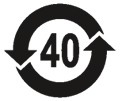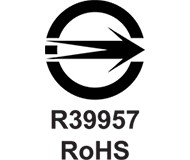위험 물질 관리
NI는 친환경 제품을 생산하기 위해 최선을 다하고 있으며, 제반 환경 및 공급망 책임 법을 준수합니다.
EU RoHS 규정 준수
특정 유해 물질 사용 제한에 관한 EU 지침(RoHS) (2011/65/EU)에서는 납, 수은 및 카드뮴과 같은 유해 물질의 사용을 제한합니다. 이는 11개 범주의 전기 및 전자 장비에 적용됩니다. NI 제품은 2017년 7월 22일 범위에 포함된 9번 카테고리 내의 산업용 모니터링 및 제어 기기에 속합니다. NI는 RoHS 지침을 완벽하게 준수합니다.
2015/863/EU 지침은 제한 물질 목록에 4개의 프탈레이트를 추가하기 위해 EU RoHS 지침 (2011/65/EU)의 부록 II를 수정했습니다. 이를 위해서는 부품의 각 동종 물질이 최대 총중량 0.1% 미만의 비스프탈레이트 (bis(2-ethylhexyl) phthalate, DEHP), 부틸벤질프탈레이트(benzyl butyl phthalate, BBP), 디부틸프탈레이트(dibutyl phthalate, DBP) 및 디이소부틸프탈레이트(diisobutyl phthalate, DIBP)를 포함해야 합니다.
NI는 새롭게 추가된 4가지 물질을 포함하는 제품들을 확인하기 위해 공급망을 조사했습니다. 대부분의 NI 제품은 2021년 7월 22일 카테고리 9, 산업용 모니터링 및 제어 기기에 대한 마감일 이전에 RoHS 지침(EU) 2015/863을 준수하는 것으로 인증되었습니다. NI 제품 인증 사이트에서 모델 번호를 검색하여 제품에 대한 적합성 문서를 다운로드하십시오.
과제
공급망에 미치는 광범위한 영향 외에도, 유해 물질을 제품에서 제거하는 데에는 다음과 같은 어려움이 따릅니다.
- 환경보호국(EPA)과 같은 조직은 특정 유해 물질의 대체 물질이 원래 유해 물질과 같거나 더 나쁜 환경 영향을 미칠 수 있음을 발견했습니다. 이 문제를 완화하기 위해 NI는 전 세계의 수많은 무역 조직과 적극적으로 협력하고 있습니다. 이러한 조직과의 협력과 공급업체와의 긴밀한 관계를 통해 NI는 재료 부문의 첨단 기술 개발과 유해 물질에 대한 전 세계 규정 준수에서 모두 선두에 서 있습니다.
- 이 분야의 규정은 빠르게 진화합니다. NI는 테스트 및 측정 연합(Test and Measurement Coalition)의 회원이며 이 조직을 통해 법률을 개선하기 위해 노력합니다.
RoHS 지침의 전문을 보십시오. NI RoHS 준수에 대한 자세한 정보는 rohs@ni.com으로 문의하십시오.
China RoHS
On January 16, 2016, the Chinese Ministry of Information Industry promulgated China's requirements for the "Management Methods for Restriction of the Use of Hazardous Substances in Electronic and Electrical Products." These requirements spell out Chinese policy on the Restriction of Hazardous Substances (RoHS) used in Electronic and Electrical Products (EEPs).
The Chinese "Management Methods" are similar to European Union RoHS requirements because they recognize the same six hazardous substances and the same maximum concentration levels. The "Management Methods" regulation also defines requirements for product labeling and hazardous substance level disclosure. The following industry standards were developed to describe the requirements:
- Labeling - SJ/T11364-2014 "Marking for the Restricted Use of Hazardous Substances in Electronic and Electrical Products"
- Maximum concentration levels - GB/T 26572-2011 "Requirements for Concentration Limits for Certain Hazardous Substances in Electronic and Electrical Products"
National Instruments meets the "Management Methods" requirements by providing appropriate labeling and hazardous substance disclosure with all products that fall under the EEP definition.
Disclosure of Hazardous Substances and Elements
SJ/T 11364-2014 requires that all EEP manufacturers supply a table disclosing toxic or hazardous substances contained in a product. Table 1 is an example of the information supplied with NI EEP products.
The table discloses hazardous substance concentration values above or below the limit requirements defined in GB/T 26572-2011. An "X" or "O" in the table row identifies whether a hazardous substance is present for each major component of the product.
Table 1. Example Toxic or Hazardous Substances and Elements Contained in Product
| Component Name | Toxic or Hazardous Substances and Elements | |||||
|---|---|---|---|---|---|---|
| Lead (Pb) | Mercury (Hg) | Cadmium (Cd) | Hexavalent chromium (Cr6+) | Polybromin- ated biphenyls (PBB) | Polybromin- ated diphenyl ethers (PBDE) | |
| Printed circuit card assembly | X | O | O | O | O | O |
| Metal enclosure | X | O | O | X | O | O |
O: Indicates that the toxic or hazardous substance contained in all of the homogeneous materials for this part is below the limit required in GB/T 26572-2011.
X: Indicates that the toxic or hazardous substance contained in at least one of the homogeneous materials used for this part is above the limit requirement in GB/T 26572-2011.
Product Marking Explanations
In accordance with the requirements specified in SJ/T 11364-2014, all NI EEPs sold in the People's Republic of China are marked with pollution control logos.
The following illustrations show the markings that apply to NI products.
Logo 1 - No part of the EEP contains toxic or hazardous substances or elements above the requirements listed in GB/T 26572-2011.

Logo 2 - Some homogenous substance within the EEP contains toxic or hazardous substances or elements above the requirements listed in GB/T 26572-2011. These substances are identified in Table 1.
The size or function of some products may prevent them from being directly marked. These products still meet the requirements of GB/T 26572-2011, and their marking information is covered in the Hazardous Substance Disclosure form that is shipped with the EEP.
Environmentally Friendly Use Period
The number in Logo 2, shown as 40 in the illustration, refers to an EEP's environmentally friendly use period (EFUP). The EFUP is the number of years from the date of manufacture that toxic or hazardous substances or elements contained in EEPs will not leak or mutate under normal operating conditions resulting in any environmental pollution, bodily injury, or damage to assets.
Manufacture Date
Manufacture dates of all National Instruments products are encoded into the product serial number. Contact your local sales office to obtain the manufacture date for your product.
Hazardous Substance Disclosure Statements
Taiwan RoHS
On July 30, 2013, Taiwan Bureau of Standards, Metrology and Inspection (BSMI), Ministry of Economic Affairs MOEA promulgated Taiwan's requirements for the "CNS15663 Guidance to reduction of the restricted chemical substances in electrical and electronic equipment." These requirements spell out Taiwanese policy on the Restriction of Hazardous Substances (RoHS) used in electronic and electrical equipment.
Taiwan "restricted chemical substances" are similar to European Union RoHS requirements because they recognize the same six hazardous substances and the same maximum concentration levels. The "restricted chemical substances" regulation also defines requirements for product labeling and hazardous substance level disclosure. The following industry standards were developed to describe the requirements:
- Labeling - CNS 15663 Section 5 "Marking Presence” requires to clearly mark “the presence conditions of the restricted substances”
National Instruments meets the requirements by providing appropriate labeling and hazardous substance disclosure with all products that fall under the BSMI electrical equipment definition.
Disclosure of Restricted Chemical Substances
CNS 15663 Section 5 requires that all manufacturers supply a table disclosing restricted substances contained in a product. Table 1 is an example of the information supplied with BSMI certified products.
The table discloses restricted substance concentration values above or below the limit requirements defined in CNS15663 Section 5. An "-" or "O" in the table row identifies whether a hazardous substance is present for each major component of the product.
표 1. Example of marking for the content of restrict substance other than exemption not exceeding the reference percentage value of presence condition.
| Unit | Restricted Substances and its Chemical Symbol | |||||
|---|---|---|---|---|---|---|
| Lead (Pb) | Mercury (Hg) | Cadmium (Cd) | Hexavalent chromium (Cr6+) | Polybromin- ated biphenyls (PBB) | Polybromin- ated diphenyl ethers (PBDE) | |
| Printed circuit card assembly | O | O | O | O | O | O |
| Metal enclosure | – | O | – | – | O | O |
O: Indicates that the percentage content of the restricted substance does not exceed the percentage of reference.
–: Indicates that the restricted substance corresponds to the exemption.
Product Marking Explanations
In accordance with the requirements specified in Section 5 "Marking of presence" of CNS 15663 all certified products clearly mark "the presence condition of the restricted substances".
The following illustration shows the markings that apply to NI products.
The mark now includes “RoHS”. The “RoHS” of the identification number indicates that “the content of restricted substance(s) other than exemption” of the products, does not exceed the reference percentage value.
Download myRIO-1900 and myRIO-1950 Chinese User Manual/下載myRIO-1900 及myRIO-1950中文手冊
Product RoHS tables
Taiwan RoHS Table for cRIO-9805
YP-12 + YC-20D1 (125V 15A 2P+E C15)
YP-16C+YC-18(250V 15A 2P+E C19)
Manufacture Date / 製造日期
Manufacture dates of all National Instruments products are encoded into the product serial number. Contact your local sales office to obtain the manufacture date for your product.
所有產品的製造日期可從序號中查詢。請與您當地的銷售辦事處聯繫以獲得產品的製造日期,或到以下網站輸入產品序號查詢製造日期。 查詢產品製造日期: https://sine.ni.com/apps/utf8/nical.main
REACH(유럽 화학물질등록·평가·승인과 규제 규정)
2006년에 유럽 의회와 이사회는 화학 물질의 등록, 평가, 승인 및 제한(REACH)에 관한 규정(EC) 번호 1907/2006을 채택했습니다. 이 규정의 주요 목표 중 하나는 유해 물질로부터 환경을 보호하는 것입니다.
REACH 추진 목표
REACH에 따라 화학 물질 제조업체와 수입업체는 이 정보를 중앙 데이터베이스에 등록해야 합니다. REACH는 또한 화학 물질의 위험을 관리하고 공급망 사용자에게 물질에 대한 안전 정보를 제공할 책임을 산업체에 부여합니다.
대상 제품의 생산업체는 제품 중량의 0.1%를 초과하는 농도로 연간 1톤 이상의 중량에 포함되었으며 고객이 노출되지 않을 수 없는 모든 초고위험 물질(SVHC)에 대해 고객에게 알려야 합니다. REACH 하에서 제품에 대상 화학 물질이 포함된 제품이 있는 회사는 물질별 승인을 요청하고 물질 사용에 대한 정당성을 입증해야 합니다. 물질을 SVHC로 식별하고 후보 목록에 포함시키면 해당 물질이 포함된 제품의 수입업체, 생산자 및 공급업체에는 특정 법적 의무가 발생할 수 있습니다.
NI의 입장 및 의무
여기에서 최신 REACH 규정 선언문을 확인하십시오.
글로벌 제조업체 및 공급업체인 NI는 기존 국제 법률과 새로 생기는 국제 법률을 지속적으로 검토합니다. NI는 또한 EPPA와 같은 공인 조직과 IEC와 같은 표준 기관에 가입하고 참여해 글로벌 요구 사항을 파악하고 있습니다.
EU의 테스트 및 측정 장비 제조업체인 NI는 연간 1톤을 초과하는 화학 물질을 생산하거나 수입하지 않습니다. 땜납과 같이 EU 제조 시설에서 사용하기 위해 구매한 모든 재료는 EU 내에서 구매되며 현재 등록 요건을 준수합니다. 또한 NI 제품은 정상적이고 예측 가능한 사용 조건에서 환경에 물질을 방출하지 않습니다.
액세서리 및 포장을 포함한 모든 NI 제품은 REACH 하에서 "물품"으로 간주됩니다. NI는 공급망을 통해 수집된 정보를 기반으로, 자사 전자 기기 제품에 NI SVHC 제품 목록에 있는 물질을 제외한 SVHC 물질이 제품 중량의 0.1%를 초과하지 않는다는 점을 확인합니다. NI는 ECHA에서 발행한 후보 목록을 정기적으로 검토하고 NI 제품에서 발견된 모든 SVHC에 응답합니다. 또한 NI는 공급망으로부터 정보를 받아 제품을 계속 안전하게 사용하는 데 필요한 변경 사항에 대한 수정된 정보를 고객에게 제공합니다. REACH 목표를 지원하기 위해 NI는 재료 공급업체에 적절한 물질 사용 정보를 제공합니다. 물품의 공급업체는 특정 조건에서 공급망 전체에 정보를 전달해야 합니다. 이 정보는 공급업체가 REACH 요건에 따라 등록해야 하는 경우 물질 사용 사례를 올바르게 기록하는 데 도움이 될 수 있습니다.
REACH 관련 특정 제품에 관한 정보는 contact@ni.com으로 문의하여 주시기 바랍니다.
분쟁 광물 거래 규제법
2010년 미국은 콩고민주공화국(DRC)에서 인도주의적 문제를 해결하기 위해 Dodd-Frank 월스트리트 개혁 및 소비자 보호법(Dodd-Frank Wall Street Reform and Consumer Protection Act) 1502조를 제정했습니다. 그 문제는 DRC 지역의 반군이 통제하는 광산에서 채취한 네 가지 광물인 금, 탄탈륨, 주석 및 텅스텐과 관련된 것입니다. 미국 증권거래위원회(SEC)에서 발표한 법률 및 후속 규칙에 따라 상장 기업은 2013 회계연도부터 다음 정보를 공개해야 합니다.
- 기능이나 그 제조 과정에 해당 분쟁 광물이 필요한 제품
- 분쟁 지역에서 입수한 분쟁 광물 사용 여부
- 제품에 사용된 광물의 출처 규명을 위한 노력
NI는 분쟁 지역에서 얻은 광물이 포함된 구성 요소를 구매하지 않도록 책임 있는 소싱 정책을 수립해놓고 있습니다. 앞으로 NI는 모든 신규 공급업체가 분쟁 광물의 원산지에 관해 신뢰할 수 있는 데이터를 제공할 능력이 있는지 평가할 것입니다. 분쟁 지역의 광물이 NI 공급망에서 발견되는 경우 그 상황을 해결하기 위해 적시에 적절한 조치가 취해질 것입니다. NI는 공급업체가 이와 유사한 방식으로 대응하기를 기대하며 이 정책을 모든 공급업체에 전달했습니다.
NI의 분쟁광물거래법(Conflict Minerals Trade Act) 준수에 대한 추가 정보는 conflictminerals@ni.com으로 문의하십시오. 최신 버전의 분쟁 광물 리포트 템플릿(CMRT)을 다운로드하십시오.

